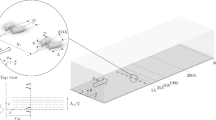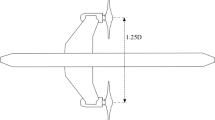Abstract
In this paper, the drag force calculation around the SUBOFF submarine in axisymmetric configuration was investigated using the “Wake Integration Technique.” This method is usually used in wind tunnels as an auxiliary method instead of the common “surface integral technique” for flow around complex geometries or shock wave flows. The results of this method are dependent on data collection vertex space, distance, and section size, where practical suggestions were made for each parameter in this research. Furthermore, the contribution of the pressure, momentum, and fluctuation terms in the total drag force were also evaluated at different cross sections. These findings can be implemented in wind tunnels with small test section length and also to compare the results obtained by the common surface integral method. Simulations were carried out at different aspect ratios at zero angles of attack, and the capabilities of this method at inclined flows were also discussed. The obtained results were also compared against the common method, and the results show only 4% deviation at zero angle.
















Similar content being viewed by others
Abbreviations
- L :
-
Body length
- D :
-
Maximum body diameter
- AR:
-
Length-to-the-diameter aspect ratio
- x, y, z :
-
Coordinate system
- \(\Delta x,\Delta y\) :
-
Grid space in x and y-direction
- d :
-
The ratio of grid space to diameter
- X :
-
Longitudinal distance from the body
- r :
-
Measurement radius
- S :
-
Surface area
- \(P\), u :
-
Local pressure and velocity
- \(P_{\infty } , U_{\infty }\) :
-
Free-stream pressure and velocity
- \(C_{\text{D}}\) :
-
Drag coefficient
- \(C_{p}\) :
-
Pressure coefficient
- \(\alpha\) :
-
Incidence angle
- \(y^{ + }\) :
-
Dimensionless wall distance
- \(\rho\) :
-
Fluid density
- \(\tau_{xx}\) :
-
Normal stress component
References
Van Dam CP (1999) Recent experience with different methods of drag prediction. Prog Aerosp Sci 35(8):751–798
Noca F, Shiels D, Jeon D (1999) A comparison of methods for evaluating time-dependent fluid dynamic forces on bodies, using only velocity fields and their derivatives. J Fluids Struct 13(5):551–578
Wu J-Z, Lu X-Y, Zhuang L-X (2007) Integral force acting on a body due to local flow structures. J Fluid Mech 576:265–286
Marongiu C, Tognaccini R (2010) Far-field analysis of the aerodynamic force by lamb vector integrals. AIAA J 48(11):2543–2555
Chao D, Van Dam C (1999) Airfoil drag prediction and decomposition. J Aircr 36(4):675–681
O’Neil K (2009) Drag and momentum in a two-dimensional vortex wake. Fluid Dyn Res 41(3):035505
Saffman P, Schatzman J (1982) An inviscid model for the vortex-street wake. J Fluid Mech 122:467–486
Gariépy M, Trépanier J-Y, Masson C (2011) Convergence criterion for a far-field drag prediction and decomposition method. AIAA J 49(12):2814–2818
Gariépy M, Trépanier J (2012) A new axial velocity defect formulation for a far-field drag decomposition method. Can Aeronaut Space J 58(02):69–82
Kusunose K, Maruyama S, Sasō A (2005) A wake integration method for airplane drag prediction. Tohoku University Press, Sendai
Coles D, Wadcock AJ (1979) Flying-hot-wire study of flow past an NACA 4412 airfoil at maximum lift. AIAA J 17(4):321–329
Rae WH, Pope A (1984) Low-speed wind tunnel testing. Wiley, New York, pp 176–178
Antonia R, Rajagopalan S (1990) Determination of drag of a circular cylinder. AIAA J 28(10):1833–1834
Janus JM, Chatterjee A (1996) Use of a wake-integral method for computational drag analysis. AIAA J 34(1):188–190
Kusunose K (1998) Drag prediction based on a wake-integral method. AIAA J 2723:1998
Kusunose K (2001) Lift analysis based on a wake-integral method. AIAA J 420:2001
Spalart PR (2008) On the far wake and induced drag of aircraft. J Fluid Mech 603:413–430
Alam MM, Zhou Y (2008) Alternative drag coefficient in the wake of an isolated bluff body. Phys Rev E 78(3):036320
Suryanarayana C, Satyanarayana B, Ramji K et al (2010) Experimental evaluation of pumpjet propulsor for an axi-symmetric body in wind tunnel. Int J Naval Archit Ocean Eng 2(1):24–33
Destarac D, Van Der Vooren J (2004) Drag/thrust analysis of jet-propelled transonic transport aircraft; definition of physical drag components. Aerosp Sci Technol 8(6):545–556
Khoshnevis A, Barzanooni V (2013) Experimental investigation of aerodynamics of a car model. Int J Adv Des Manuf Technol 6(1):41–48
Khoshnevis A, Barzanooni V (2012) Experimental investigation of the trailer wake effects on the aerodynamics of a car model. J Fluid Mech Aerodyn 1(1):13–27
Manshadi MD, Esfandeh S, Dehghan AA (2015) Experimental investigation of the wake of a submarine model by five-hole probe in a wind tunnel. Modares Mech Eng 15(8):29–40
Toubin H, Bailly D (2015) Development and application of a new unsteady far-field drag decomposition method. AIAA J 53(11):3414–3429
Toubin H, Bailly D, Costes M (2016) Improved unsteady far-field drag breakdown method and application to complex cases. AIAA J 54(6):1907–1921
Son O, Cetiner O (2016) Drag prediction in the near wake of a circular cylinder based on DPIV data. J Appl Fluid Mech 9(4):1963–1968
Wilcox DC (1998) Turbulence modeling for CFD: DCW industries La Canada
Groves NC, Huang TT, Chang MS (1989) Geometric characteristics of DARPA (Defense Advanced Research Projects Agency) SUBOFF Models (DTRC Model Numbers 5470 and 5471), DTIC Document
Huang T, Liu H (1992) Measurements of flows over an axisymmetric body with various appendages in a wind tunnel: the DARPA SUBOFF experimental program. In: 19th symposium on naval hydrodynamics, Seoul, South Korea
Roddy RF (1990) Investigation of the stability and control characteristics of several configurations of the DARPA SUBOFF model (DTRC Model 5470) from captive-model experiments, DTIC Document
Jones W, Launder B (1972) The prediction of laminarization with a two-equation model of turbulence. Int J Heat Mass Transf 15(2):301–314
ANSYS (2015) ANSYS Fluent User Guide, Technical Report Release 16.1, Canonsburg, Pennsylvania: ANSYS Inc
Author information
Authors and Affiliations
Corresponding author
Additional information
Technical Editor: Daniel Onofre de Almeida Cruz, D.Sc..
Publisher's Note
Springer Nature remains neutral with regard to jurisdictional claims in published maps and institutional affiliations.
Rights and permissions
About this article
Cite this article
Talezade Shirazi, A., Dehghan Manshadi, M. Streamlined bodies drag force estimation using wake integration technique. J Braz. Soc. Mech. Sci. Eng. 42, 293 (2020). https://doi.org/10.1007/s40430-020-02373-8
Received:
Accepted:
Published:
DOI: https://doi.org/10.1007/s40430-020-02373-8




